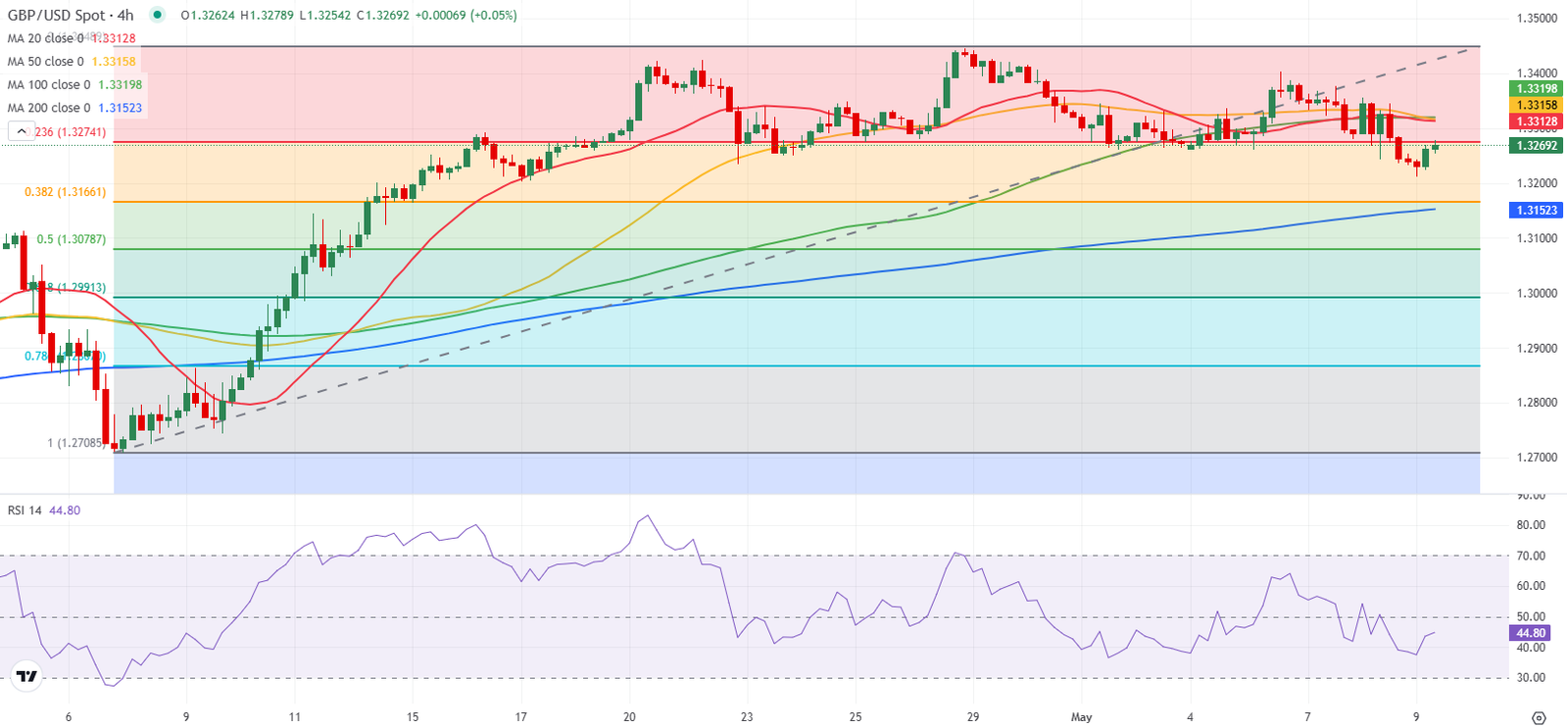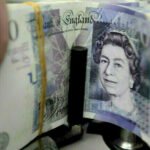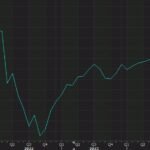- GBP/USD trades in positive territory above 1.3250 early Friday.
- The Bank of England lowered the policy rate by 25 bps as expected.
- The near-term technical outlook points to a loss of bearish momentum.
Following a two-day slide, GBP/USD dropped toward 1.3200 early Friday and touched a fresh multi-week low before regaining its traction. The pair trades above 1.3250 in the European session but remains below key technical resistance levels.
British Pound PRICE This week
The table below shows the percentage change of British Pound (GBP) against listed major currencies this week. British Pound was the weakest against the US Dollar.
| USD | EUR | GBP | JPY | CAD | AUD | NZD | CHF | |
|---|---|---|---|---|---|---|---|---|
| USD | 0.79% | -0.05% | 0.42% | 0.86% | 0.88% | 1.02% | 0.73% | |
| EUR | -0.79% | -0.56% | -0.08% | 0.33% | 0.36% | 0.50% | 0.21% | |
| GBP | 0.05% | 0.56% | 0.25% | 0.90% | 0.92% | 1.07% | 0.77% | |
| JPY | -0.42% | 0.08% | -0.25% | 0.43% | 0.45% | 0.67% | 0.42% | |
| CAD | -0.86% | -0.33% | -0.90% | -0.43% | -0.28% | 0.16% | -0.12% | |
| AUD | -0.88% | -0.36% | -0.92% | -0.45% | 0.28% | 0.14% | -0.14% | |
| NZD | -1.02% | -0.50% | -1.07% | -0.67% | -0.16% | -0.14% | -0.29% | |
| CHF | -0.73% | -0.21% | -0.77% | -0.42% | 0.12% | 0.14% | 0.29% |
The heat map shows percentage changes of major currencies against each other. The base currency is picked from the left column, while the quote currency is picked from the top row. For example, if you pick the British Pound from the left column and move along the horizontal line to the US Dollar, the percentage change displayed in the box will represent GBP (base)/USD (quote).
The Bank of England (BoE) announced on Thursday that it cut the policy rate by 25 basis points (bps) to 4.25%, as widely anticipated. Unexpectedly, two policymakers voted in favor of holding the policy rate unchanged, while two others voted for a 50 bps cut. Meanwhile, the BoE noted in its policy statement that a gradual and careful approach to further withdrawal of monetary policy restraint remains appropriate.
Although GBP/USD edged higher with the immediate reaction to the BoE event, the broad-based US Dollar (USD) strength forced the pair to turn south during the American trading hours on Thursday. US President Donald Trump held a press conference to announce a trade deal with the UK and said that tariffs with China could be lowered, easing worries about a deepening trade conflict and supporting the USD.
Investors will pay close attention to comments from Federal Reserve (Fed) officials heading into the weekend. The CME FedWatch Tool shows that markets currently price in about a 14% probability of a 25 bps Fed rate cut in June. In case Fed officials adopt a hawkish tone and reiterate the need for patience with regard to rate cuts, given the uncertainty surrounding the inflation outlook, the USD could preserve its strength and cap GBP/USD’s upside.
In the meantime, investors could turn cautious ahead of the US-China trade talks this weekend. In this scenario, profit-taking toward the end of the European session could cause the USD to weaken against its rivals.
GBP/USD Technical Analysis

The Relative Strength Index (RSI) indicator on the 4-hour chart recovers toward 50, pointing to a loss of bearish momentum. Nevertheless, technical buyers could remain reluctant to bet on a leg higher until GBP/USD clears key resistance levels at 1.3275 (Fibonacci 23.6% retracement level of the latest uptrend) and 1.3310-1.3320 (20-day Simple Moving Average (SMA), 50-period, 100-period SMAs on the 4-hour chart). A daily close above the latter could open the door for additional gains toward 1.3400 (static level).
On the downside, interim support seems to have formed at 1.3230 (static level) before 1.3170 (Fibonacci 38.2% retracement) and 1.3150 (200-period SMA).
Pound Sterling FAQs
The Pound Sterling (GBP) is the oldest currency in the world (886 AD) and the official currency of the United Kingdom. It is the fourth most traded unit for foreign exchange (FX) in the world, accounting for 12% of all transactions, averaging $630 billion a day, according to 2022 data.
Its key trading pairs are GBP/USD, also known as ‘Cable’, which accounts for 11% of FX, GBP/JPY, or the ‘Dragon’ as it is known by traders (3%), and EUR/GBP (2%). The Pound Sterling is issued by the Bank of England (BoE).
The single most important factor influencing the value of the Pound Sterling is monetary policy decided by the Bank of England. The BoE bases its decisions on whether it has achieved its primary goal of “price stability” – a steady inflation rate of around 2%. Its primary tool for achieving this is the adjustment of interest rates.
When inflation is too high, the BoE will try to rein it in by raising interest rates, making it more expensive for people and businesses to access credit. This is generally positive for GBP, as higher interest rates make the UK a more attractive place for global investors to park their money.
When inflation falls too low it is a sign economic growth is slowing. In this scenario, the BoE will consider lowering interest rates to cheapen credit so businesses will borrow more to invest in growth-generating projects.
Data releases gauge the health of the economy and can impact the value of the Pound Sterling. Indicators such as GDP, Manufacturing and Services PMIs, and employment can all influence the direction of the GBP.
A strong economy is good for Sterling. Not only does it attract more foreign investment but it may encourage the BoE to put up interest rates, which will directly strengthen GBP. Otherwise, if economic data is weak, the Pound Sterling is likely to fall.
Another significant data release for the Pound Sterling is the Trade Balance. This indicator measures the difference between what a country earns from its exports and what it spends on imports over a given period.
If a country produces highly sought-after exports, its currency will benefit purely from the extra demand created from foreign buyers seeking to purchase these goods. Therefore, a positive net Trade Balance strengthens a currency and vice versa for a negative balance.















